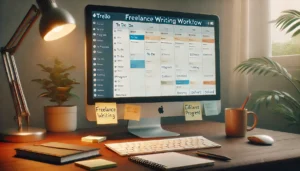When you’re deep into a writing project, it can feel tempting to push through without stopping. But research—and real-world results—show that regular, intentional breaks can actually make you more productive, not less.
As a freelance writer, breaks are your secret weapon for maintaining creativity, focus, and energy throughout the day.
In this article, you’ll learn how to take smart breaks that support—not sabotage—your writing workflow.
Why Breaks Matter for Freelancers
When you’re your own boss, there’s often pressure to “grind.” But our brains aren’t designed for nonstop focus. Just like muscles need rest between sets, your brain needs space to recharge.
Taking the right kind of break can:
- Refresh mental focus
- Reduce decision fatigue
- Prevent burnout
- Improve idea generation and writing flow
- Help you work more consistently throughout the day
It’s not just about stepping away—it’s about stepping back wisely.
The Science Behind Breaks
Cognitive studies show that focus and productivity follow an ultradian rhythm—natural 90-minute cycles of peak energy and decline. After about 90 minutes of work, your brain starts to lose focus, even if you feel “fine.”
Breaks interrupt this decline and restore your mental resources.
💡 Fun fact: Some of the most successful creatives in history (like Hemingway and Maya Angelou) scheduled daily breaks—on purpose.
When to Take Breaks: Timing Is Everything
Short Writing Sprints (Pomodoro Style)
- Work: 25 minutes
- Break: 5 minutes
- After 4 rounds: 15–30 minute break
Deep Work Sessions
- Work: 90 minutes
- Break: 20–30 minutes
- Do 2–3 deep work sessions per day
You can also use natural breaks:
- Between clients/projects
- After completing a difficult section
- When energy or attention starts to dip
The key is to take the break before burnout hits.
What Makes a Break “Smart”?
Not all breaks are created equal. Scrolling Instagram or checking email isn’t really a break—it just swaps one kind of stimulation for another.
Smart Break Activities:
- 💧 Drink water or tea
- 🚶 Go for a short walk
- 🧘 Do 5 minutes of stretching or breathing
- ☀️ Get some sunlight
- 🧠 Let your mind wander (this is when creativity thrives)
- 📓 Journal or brain dump
- 🎶 Listen to music (non-lyrical helps reset focus)
Avoid During Breaks:
- Checking social media
- Reading emails
- Consuming heavy news
- Doing chores that stress you out
Protect your break time like you protect your writing time.
How to Build Breaks Into Your Writing Routine
Here’s how to make breaks part of your productivity system:
1. Pre-Schedule Them
Add break times into your Google Calendar or Notion planner. Treat them like meetings with your brain.
2. Set a Timer
Use apps like Pomofocus, TomatoTimer, or just your phone to remind you when it’s time to stop.
3. Create a Menu of Break Ideas
Have a list of 5–10 go-to break activities that work for you. Post it near your desk. When you’re tired, decision fatigue will stop you from choosing something healthy unless the options are already there.
4. Change Your Environment
Even a small change—like stepping outside or switching rooms—can reset your brain and energy.
5. End Your Break with a Cue
Use a short ritual (e.g., turning on music, lighting a candle, opening your draft) to tell your brain: Break’s over, time to focus.
Breaks vs. Distractions: Know the Difference
Breaks are intentional, scheduled, and replenishing.
Distractions are unplanned, often digital, and usually deplete your energy.
One boosts momentum.
The other breaks it.
Don’t confuse the two.
Final Thoughts: Rest Is Part of the Process
Writing isn’t just about words on a page—it’s about mental clarity, energy, and focus. Smart breaks help you protect all three.
Whether you’re tackling a single blog post or writing five articles in a day, your brain needs downtime to produce its best work.
So give yourself permission to pause. You’re not being lazy—you’re being strategic.



